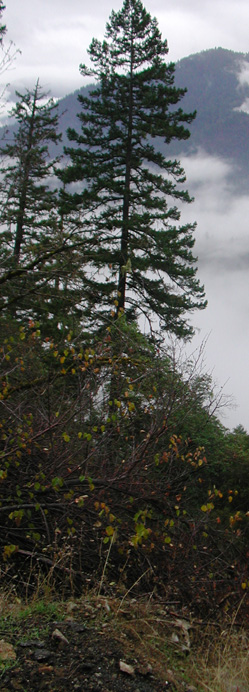Bibliography Background About KRIS
The Regulation of Timber Harvest on Private Lands in California
 The harvesting of timber on private lands in California is regulated by the State. California's first Forest Practice Act [FPA], as the suite of governing Public Resources Code sections is known, was adopted by the Legislature during World War II. That 1945 act created a simple requirement that any person who intended to cut "merchantable" timber must first notify the State Forester.
The harvesting of timber on private lands in California is regulated by the State. California's first Forest Practice Act [FPA], as the suite of governing Public Resources Code sections is known, was adopted by the Legislature during World War II. That 1945 act created a simple requirement that any person who intended to cut "merchantable" timber must first notify the State Forester.
The FPA has evolved steadily since the 1940s. A set of Forest Practice Rules [FPRs], with which to implement the FPA, has been developed by the State Board of Forestry [BOF], a body which has been in existence since 1855 [Clar]. Until the 1970s, the FPRs were adopted by the Board on the recommendations of landowner-based district practice committees.
In the early 1970s the landowners' direct role in the FPA's rulemaking process was found by the courts to be unconstitutional and the FPA was nullified. In the California Legislature's subsequent reenactment of the FPA, the act was considerably modernized to reflect the public's growing interest in fish and wildlife conservation, water quality protection, and the general sustainability of the state's forest industry. That "Nejedly-Z'berg Forest Practice Act of 1973" is essentially California's forest regulation statute of today.
The FPA requires that any timber harvest on private lands must first be advanced in a Timber Harvest Plan [THP] prepared by a State-registered professional forester [RPF] and submitted to the State Department of Forest and Fire Protection [CDF] for its prior review and approval. The pubic has an opportunity to review and comments on these THPs.
In 1975 the courts held that State-approved timber harvests are "projects", as that term is used in the California Environmental Quality Act [CEQA]. That decision would have required that an environmental impact report [EIR] be prepared before CDF could consider each year's slate, about 1,200-1,400, of THPs. Instead, the Legislature amended CEQA to create the "functional equivalent process." In 1976 the Secretary of the Resources Agency certified that the FPR/THP process is the functional equivalent of an EIR. The Secretary's action took into consideration the number of FPR sections that require protection of soil, water, plant, fish, and wildlife resources.
CEQA, like its National Environmental Policy Act [NEPA] progenitor, requires consideration, in the approval of any project, of adverse environmental effects which might not, in and of themselves, be significant but which, when taken together with additional, similar effects in the same project area, might then cause significant adverse environmental effects. Timber harvests, like virtually any other watershed management activity, have effects on the environment. How to measure, assess, prevent or mitigate these "cumulative watershed effects", in order to assure compliance with CEQA and other environmental statutes, is a subject that CDF and the BOF continue to pursue.
Coats and Miller (1980) noted that timber harvest over large portions of a watershed were likely to have negative impact on streams and fish. The National Marine Fisheries Service (2000) made recommendations for changing California FPRs in order to better protect aquatic habitat and anadromous salmonids, but suggestions have not been incorporated into the rules. Ligon et al. (1999) found that California FPRs were not protecting salmon and steelhead resources from cumulative watershed effects. Dunne et al. (2001) recommend that "responsibility for the assessments be taken out of Timber Harvest Applications and given to a new unit of a State agency, which would make whole-watershed assessments of how land use alters the risk of damage to ecosystem values."
Reference
Clar, C. Raymond. 1959. California government and forestry, from Spanish days until the creation of the Department of Natural Resources in 1927. Div. of For., Dept. of Nat. Res., Sacramento. 623 p.
Coats, R.N. and T.O. Miller. 1981. Cumulative silvicultural impacts on watersheds: A hydrologic and regulatory dilemma. Environmental Management. Volume 5, No. 2, pp. 147-160. [266k]**
Dunne, T., J. Agee, S. Beissinger, W. Dietrich, D. Gray, M. Power, V. Resh, and K. Rodrigues. 2001. A scientific basis for the prediction of cumulative watershed effects. The University of California Committee on Cumulative Watershed Effects. University of California Wildland Resource Center Report No. 46. June 2001. 107 pp. [555k]
Ligon, F., A. Rich, G. Rynearson, D. Thornburgh, and W. Trush. 1999. Report of the scientific review panel on California Forest Practice Rules and salmonid habitat. Prepared for the Resources Agency of California and the National Marine Fisheries Service. Sacramento, CA. 181 pp. [2.83Mb]
National Marine Fisheries Service. 2000. Salmonid guidelines for forestry practices in California. NMFS Southwest Region, Long Beach, CA [62 kb]
